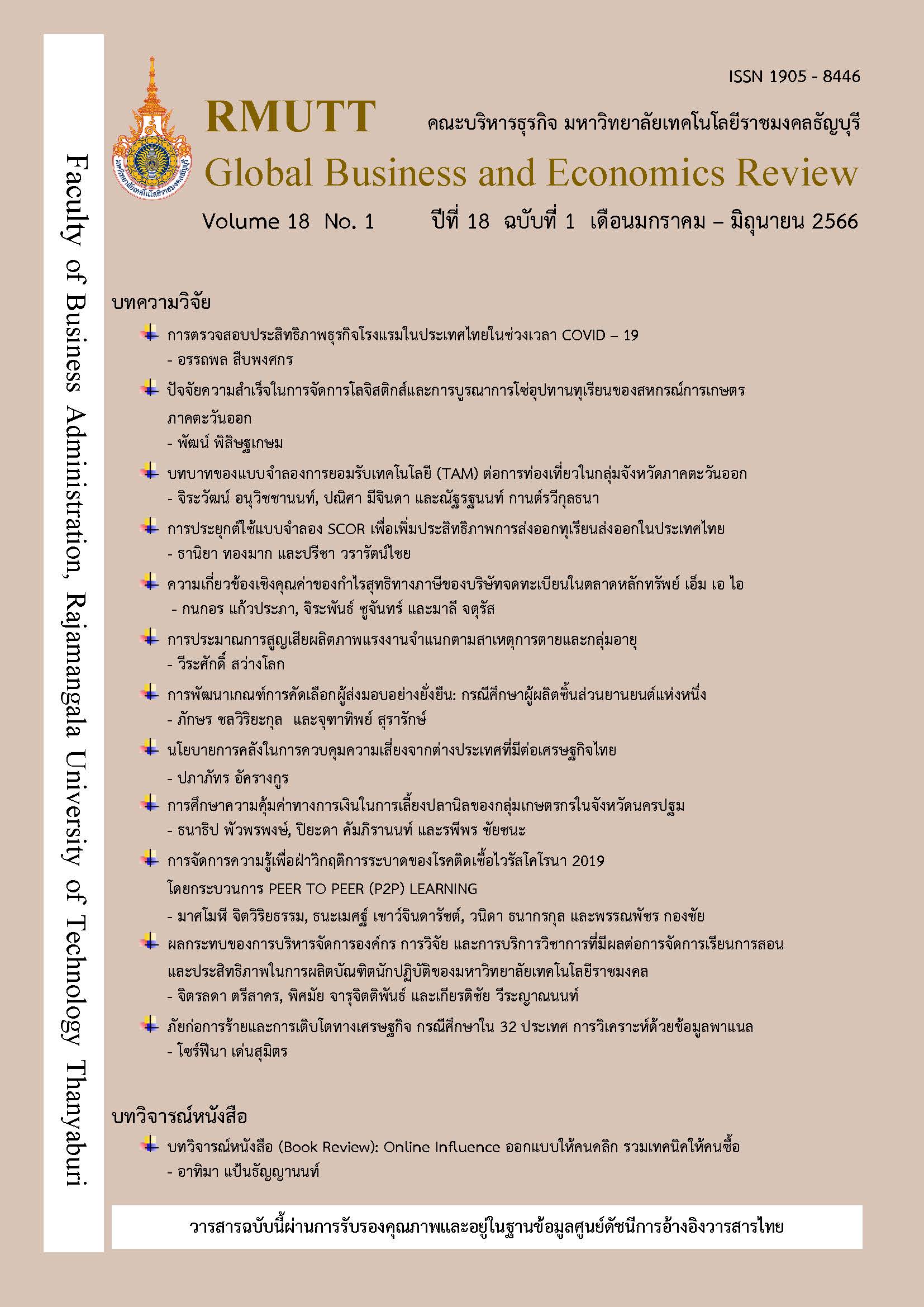TERRORISM & ECONOMIC GROWTH IN 32 COUNTRIES USING PANEL DATA APPROACH
Keywords:
Terrorism, Panel Data, Economic Growth, GDP, SocioeconomicsAbstract
The aim of this study is to examine the relationship between terrorism and economic growth in 32 countries. For empirical analysis, a panel study is conducted applying annual data for the period 2005 – 2019, and a multiple linear regression least square is estimated. Panel unit root, panel least squares estimation, panel normality, panel multicollinearity as well as panel heteroskedasticity approaches are employed, respectively. The results of the study reveal that the impact of terrorism on economic growth is significantly negative. A one percent increase in terrorism decreases real GDP by 0.0016 percent. Moreover, the estimated model shows a high R square value, no serial correlation nor heteroskedasticity in the residuals, no multicollinearity, and the residuals are normally distributed.
References
Araz-Takay, B., Arin, K. P., & Omay, T. (2009). The Endogenous and NonLinear Relationship between Terrorism and Economic Performance: Turkish Evidence. Defence and Peace Economics, 20(1), 1-10.
Blomberg, S. B., Hess, G. D., & Orphanides, A. (2004). The Macroeconomic Consequences of Terrorism. Journal of Monetary Economics, 51(5), 1007-1032.
Bravo, A. B., & Dias, C. M. (2006). An Empirical Analysis of Terrorism: Deprivation, Islamism and Geopolitical Factors. Defence and Peace Economics, 17(4), 329-341.
Breusch, T. S., & A. R. Pagan (1979). A Simple Test for Heteroskedasticity and Random Coefficient Variation. Econometrica, 48, 1287–1294.
Chesney, M., Reshetar, G., & Kamran, M. (2011). The Impact of Terrorism on Financial Markets: An Empirical Study. Journal of Banking and Finance, 35, 253-267.
Chuku, C., Abang, D., & Isip, I. A. (2019). Growth and Fiscal Consequences of Terrorism in Nigeria. Defence and Peace Economics, 30(5), 549–569.
Collier, P., Elliott, L., Hegre, H., Hoeffler, A., Reynal-Querol, M., & Sambanis, N. (2003). Breaking the Conflict Trap: Civil War and Development Policy. A World Bank Policy Research Report.
Densumite, S. (2013). Violence and Raw Rubber Production Growth: A Case Study of Yala Province, Thailand. Songklanakarin Journal of Social Sciences & Humanities, 19(4). 39-70.
Eckstein, Z., & Tsiddon, D. (2004). Macroeconomic Consequences of Terror: Theory and the Case of Israel. Journal of Monetary Economics, 51(5), 971–1002.
Enders, W., & Sandler, T. (1996). Terrorism and foreign direct investment in Spain and Greece. Kyklos, 49(3), 331–352.
Fatima, M., Latif, M., & Chugtai, S. F. (2014). Terrorism and its Impact on Economic Growth: Evidence from Pakistan and India. Middle-East Journal of Scientific Research, 22(7), 1033-1043.
Freytag, A., Kruger, J. J., Meierrieks, D., & Schneider, F. (2011). The Origins of Terrorism: Cross-Country Estimates of Socio-Economic Determinants of Terrorism. European Journal of Political Economy, 27(1), S5–S16.
Gaibulloev, K., & Sandler, T. (2008). Growth Consequences of Terrorism in Western Europe. Kyklos, 61(3), 411–424.
Gillani, S. Y., Rehman, H. U., & Gill, A. R. (2009). Unemployment, Poverty, Inflation and Crime Nexus: Cointegration and Causality Analysis of Pakistan. Pakistan Economic and Social Review, 47(1), 79-98.
Godfrey, L. G. (1978). Testing for Multiplicative Heteroscedasticity. Journal of Econometrics, 8, 227–236.
Gries, T., Krieger, T., & Meierrieks, D. (2011). Causal Linkages Between Domestic Terrorism and Economic Growth. Defence and Peace Economics, 22(5), 493-508.
Gupta, S., Clements, B., Bhattacharya, R., & Chakravarti, S. (2004). Fiscal Consequences of Armed Conflict and Terrorism in Low- and Middle-Income Countries. European Journal of Political Economy, 20(2), 403–421.
Kasperowicz, R. (2014). Economic Growth and Energy Consumption in 12 European Countries: A Panel Data Approach. Journal of International Studies, 7(3), 112-122.
Khan, A., Ruiz Estrada, M. A., & Yusof, Z. (2016). Terrorism and India: An Economic Perspective. Quality and Quantity, 50(4), 1833–1844.
Kinyanjui, S. (2014). The Impact of Terrorism on Foreign Direct Investment in Kenya. International Journal of Business Administration, 5(3), 148-157.
Malik, Z., & Zaman, K. (2013). Macroeconomic Consequences of Terrorism in Pakistan. Journal of Policy Modeling, 35, 1103–1123.
Meierrieks, D., & Gries, T. (2013). Causality between Terrorism and Economic Growth. Journal of Peace Research, 50(1), 91–104.
Mirza, D., & Verdier, T. (2008). International Trade, Security and Transnational Terrorism: Theory and a Survey of Empirics. Journal of Comparative Economics, 36, 179–194.
Nasir, M., Arif, A., Rehman, F. U., & Tariq, M. S. (2008). Terrorism and Economic Growth: A Case Study of Pakistan. GCU Economic Journal, 41(2).
Nisar, S., Lodhi, R. N., Farooq, K., & Idrees, Q. (2015). Exploring the Nexus: Terrorism and Economic Growth in Pakistan. Journal of Independent Studies and Research-Management, Social Sciences and Economics, 13(2), 99-111.
Nitsch, V., & Schumacher, D. (2004). Terrorism and International Trade: An Empirical Investigation. European Journal of Political Economy, 20, 423–433.
Polachek, S. W. (1980). Conflict and Trade. Journal of Conflict Resolution, 24, 55-78.
Safdar, M. (2020). The Impact of Terrorism on Economic Growth in Pakistan: An Empirical Analysis. Bulletin of Business and Economics, 9(4), 191- 201.
Saleem, Q., Sidra, Rauf, A., & Muhammad Abubakar Siddique, H. (2020). Impact of Terrorism on Economic Growth in South Asian Country. International Journal of Economics and Financial Issues, 10(4), 185-191.
Shahbaz, M. (2013). Linkage between Inflation, Economic Growth and Terrorism in Pakistan. Economic Modelling, 32, 496-506.
Solow, R. M. (1956), A Contribution to the Theory of Economic Growth. Quarterly Journal of Economics, 70, 65-94.
Zakaria, M., Jun, W., & Ahmed, H. (2019). Effect of Terrorism on Economic Growth in Pakistan: An Empirical Analysis. ECONOMIC RESEARCH-EKONOMSKA ISTRAZIVANJA, 32(1), 1794-1812.
Downloads
Published
How to Cite
Issue
Section
License
Copyright (c) 2023 โซร์ฟีนา เด่นสุมิตร

This work is licensed under a Creative Commons Attribution-NonCommercial-NoDerivatives 4.0 International License.
The articles published in this journal are the intellectual property of their respective authors.
The views and opinions expressed in each article are solely those of the individual authors and do not reflect the positions of Rajamangala University of Technology Thanyaburi or any of its faculty members. All components and content of each article are the sole responsibility of the respective authors. In the event of any errors, the authors shall bear full responsibility for their own work.








